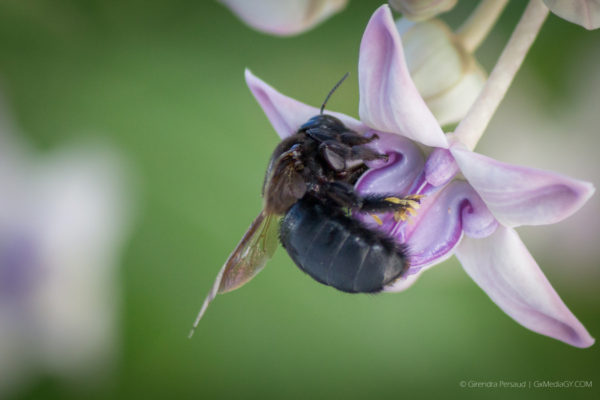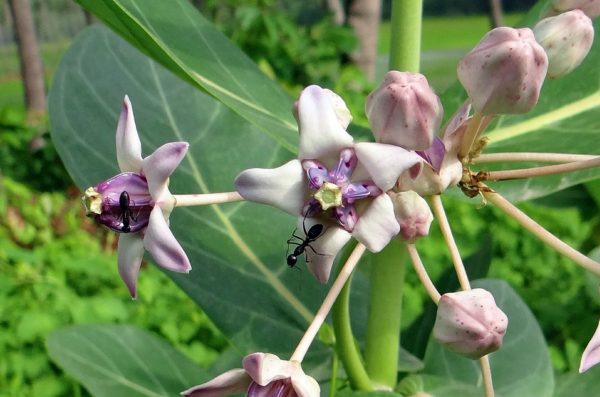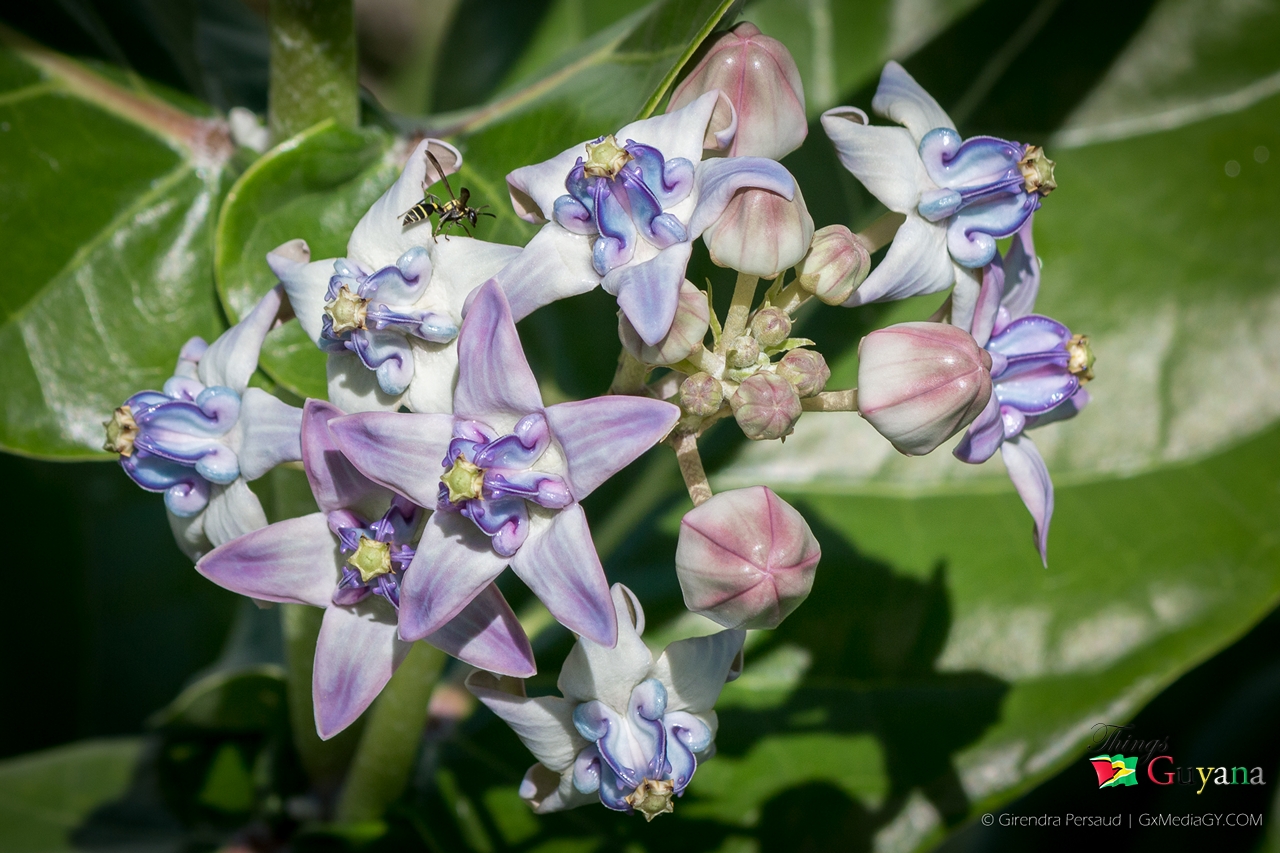The Madar plant can be easily recognized by the unique look of the tiny crown-like flowers that adorn these plants. They are a common thing to expect in gardens and even growing wild in Guyana. In Guyana, the madar flower is known to be used in the Hindu religion for worship and as decoration. Devotees of Lord Shiva would use these auspicious flowers in prayers and most Hindus would have these plants growing in their yards and flower gardens. The Madar flower is called the crown flower but known by several other names including aak (India) widuri, giant milkweed, giant callotrope, swallow-wort and the Spanish and French variation ‘mudar’. The scientific name for Madar is Calotropis gigantea.

Bee on a Madar Flower – Photo by Girendra Persaud
Origins of Madar
The Madar plant is native to several countries in Asia including Cambodia, Indonesia, Malaysia, the Philippines, Thailand, Sri Lanka, India, China, Pakistan, Nepal, and also tropical Africa. Calotropis gigantea grows a large number of countries because of its ability to grow in most soil types. Madar plants are grown in Guyana and the Caribbean.
Interesting Tips
- Calotropis gigantea is poisonous, especially the milky cut that erupts when the tree is cut or flower picked.
- The Madar plant is common in India in the compounds of temples.
Scientific Classification of Madar
- Kingdom: Plantae
- Clade: Tracheophytes
- Clade: Angiosperms
- Clade: Eudicots
- Clade: Asterids
- Order: Gentianales
- Family: Apocynaceae
- Genus: Calotropis
- Species: C. gigantea
Description of Madar

Madar Plant – Image Source: https://www.needpix.com/photo/214879/crown-flower-aak-calotropis-gigantea-asclepiadaceae.
The Madar plant is a large, beautiful and evergreen shrub that grows from four (4) to as high as ten (10) feet tall. it has many white, hairy branches with stems about twenty (20) cm in diameter. The leaves are typically four to eight (4-8) inches long and intersecting, narrow at the base of the stems and oblong. The inflorescence consists of a number of short flower stalks. The flowers themselves are a mixture of white and lavender with five petals and a calyx divided in five at the base. Madar fruits are typically a pair of follicles with many, hairy seeds.
Uses of Madar
- The flowers of Calotropis gigantea are widely used all over the world for decoration and religious purposes. Madar flowers were to be popular with the Hawaiian Queen Liliuokalani, who considered them as a symbol of royalty and wore them strung into leis. In Cambodia, they are used in funerals to decorate the urn or sarcophagus and the interior of the house holding the funeral. In Thailand, they are used in various floral arrangements.
- Madar plants (Calotropis gigantea) produces a durable fibre known as bowstring of India which is used in the making of ropes, carpets, fishing nets, and sewing thread.
- Latex from plants in the family Apocynaceae including Calotropis gigantea (Madar) is used as a poison for arrows in Africa.
- In Ayurveda, the Indian traditional medicine system, the madar plant has been used for many years. The roots and leaves are used to treat asthma and shortness of breath while the bark treats liver and spleen diseases. However, the plant is used in the treatment of skin, digestive, respiratory, circulatory and neurological disorders and was used to treat fevers, elephantiasis, nausea, vomiting, and diarrhoea.
The Madar plant is a noteworthy one, not only in Guyana but all over the world. The madar flowers are the most popular part of the plant because of their beauty and usage in Hindu worship in Guyana, but other parts of the plant are just as useful; they are used to make ropes, and treat a number of diseases. Madar plants or Calotropis gigantea will make an excellent addition to a flower garden or to decorate the front of lawns.
Article References
- https://wilderness-explorers.com/wp-content/uploads/2014/03/WILDERNESS-EXPLORERS-CHECKLIST-MEDICINAL-PLANTS.pdf
- https://www.cabi.org/isc/datasheet/16847
- https://en.wikipedia.org/wiki/Calotropis_gigantea
- http://tropical.theferns.info/viewtropical.php?id=Calotropis+gigantea
- http://www.efloraofgandhinagar.in/shrub/calotropis-gigantea
Last updated: 2020-03-05







